30+ of the best tomato varieties to grow this summer
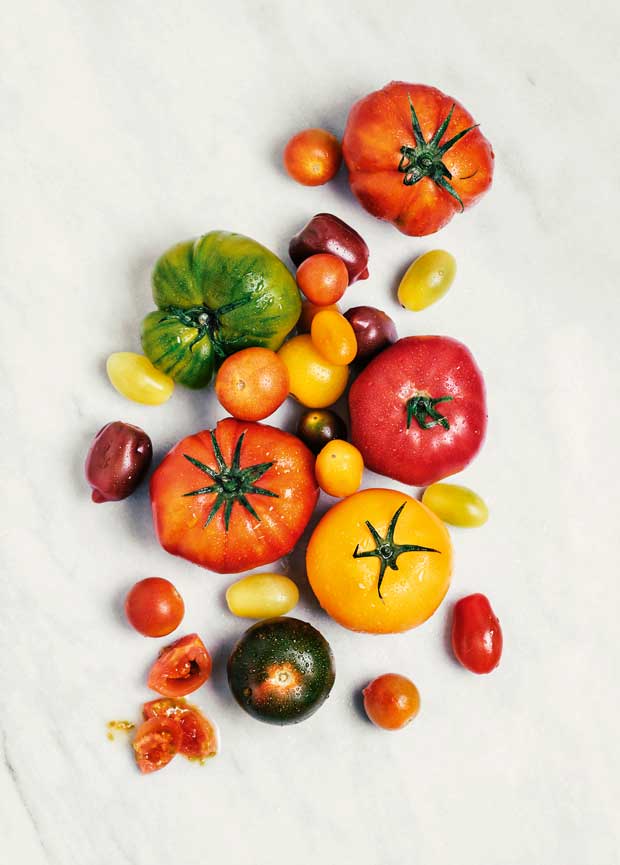
There are hundreds of varieties to try but these ones get top reviews.
Words: Jane Wrigglesworth
A tomato is a tomato is a tomato, except when chemical analysis shows it to contain high levels of the heart-healthy antioxidant tetra-cis-lycopene. Then it becomes an overnight sensation.
Tetra-cis-lycopene is a highly bioavailable form of lycopene. Studies have shown that high lycopene intake is associated with decreased risk of heart disease and cancer, especially prostate cancer.
But it’s not the red toms that score the highest for tetra-cis-lycopene. The true gems are the golden-orange ones.
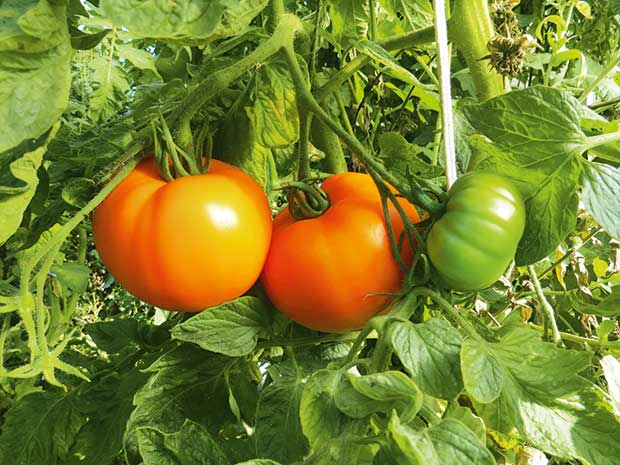
Moonglow.
“It is our understanding that the first cultivated tomatoes discovered growing in Mexico in the early 1500s, and which were taken to Europe, were golden-orange in colour and would have contained tetra-cis-lycopene,” says Mark Christensen, Research Director of Heritage Food Crops Research Trust based in Wanganui.
“As crossings occurred to make red tomatoes, the lycopene changed to the all-trans-lycopene form, which is not easily absorbed by the human body.”
All-trans-lycopene is better absorbed the body when it’s cooked. However, tetra-cis-lycopene has good bioavailability when the tomato is consumed fresh, which is what many people prefer. But there is one obstacle to better health via tomato. Not all tomatoes with a golden-orange hue contain tetra-cis-lycopene.
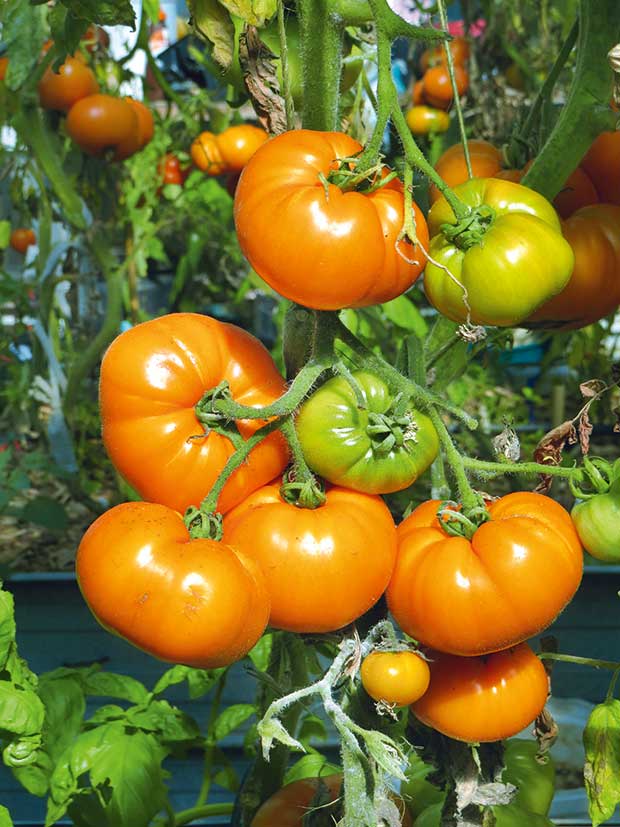
Hurma Ukrainian.
“This colour can also be expressed by beta-carotene,” says Mark. “It is necessary to chemically analyse each tomato variety to verify whether or not it contains tetra-cis-lycopene.”
Luckily, Plant & Food Research has done just that. It analysed more than 500 heritage tomatoes provided by Mark, identifying several varieties with high levels of tetra-cis-lycopene*:
• Amish Yellowish Orange Oxheart, which had the highest score of 8.21;
• Olga’s Round Golden Chicken Egg, score 7.27;
• Orange Fleshed Purple Smudge, score 6.99.
*See full table here.
It doesn’t mean you have to stop growing red tomatoes. They contain heath-giving nutrients, including lutein, beta-carotene, and all-trans-lycopene which is still beneficial when processed.
TASTE
Modern tomato varieties have their benefits. Many are prolific producers and have been bred to prevent splitting and withstand diseases.
Then there’s the flavour. Kay Baxter, garden guru and co-founder of the Koanga Institute, says taste is about a lot of things: flavour, sweetness, texture, acidity, look and smell.
“The way we grow our tomatoes has a huge effect on taste and flavour. The higher the brix (a measure of sugar levels), the higher the sugar content and complexity of flavour. So how we grow them has just as much impact on flavour as the genetics.”
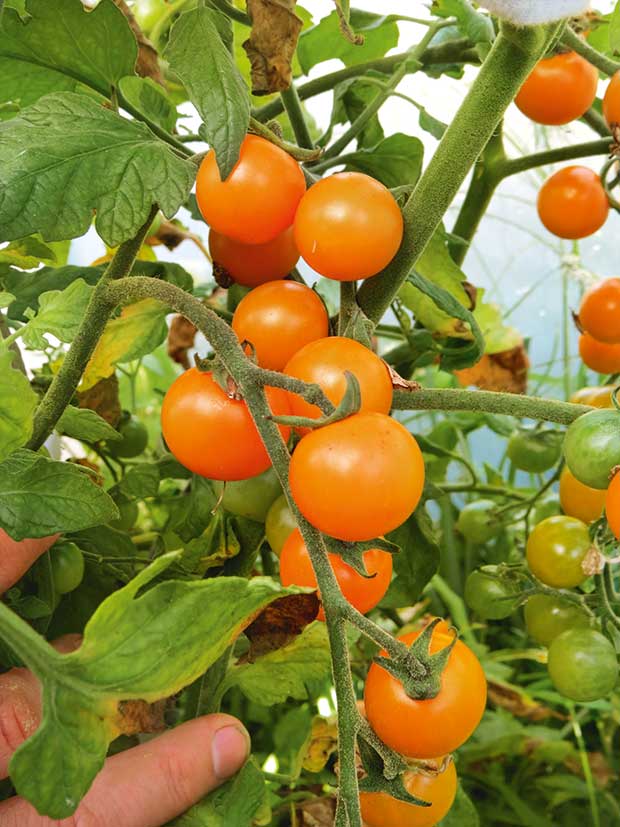
Golden Eye.
Koanga grows its tomatoes to be as nutrient-dense as possible.
“The easiest way to grow high-brix tomatoes is to fertilise them with EF Cal Phos. It’s an Environmental Fertiliser product, certified organic. It gets the calcium and phosphate to the plants how they need it, balanced, available and fast.”
EF Cal Phos can be applied to plants in water using a watering can or backpack sprayer.
DISEASE PREVENTION
To avoid diseases, Gerard Martin of Kings Seeds sows his first batch of tomatoes in September to miss the early blight of spring, and October winds.
“I then do a second sowing in early December to give a mid-late summer crop,” he says.
His secret is to use plenty of organic matter to enhance his soil. “Tomatoes love well-rotted mulch but hate too much nitrogen, they won’t set fruit.”
The biggest pests in his Bay of Plenty garden are shield bugs and early blight. “Psyllids don’t seem to be a problem at my place. Maybe all my beneficial-insect plants help by keeping the predator insect numbers up to eat the psyllids.”
His favourite tomato type is the determinates. “I prefer determinate/bush tomato plants to indeterminate/tall tomatoes. They are easier to manage and don’t catch the big winds, which I occasionally get, living on a ridge.”
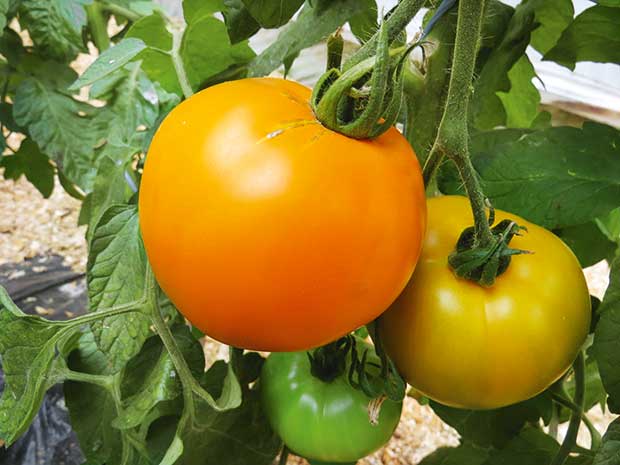
Golden Green.
Southland’s Robert Guyton is a writer, permaculturist, forest gardener and a regional councillor for Environment Southland. He has a taste for cherry tomatoes (most of which are indeterminate) and some determinate varieties like Baxter’s Early Blush, Green Grape and Golden Nugget. The one thing they have in common: they are all ‘heirloom’ (heritage) varieties.
“My taste in tomatoes is very unsophisticated. I love the cherries, the tiny, numerous, bite-sized red, yellow and orange beauties that hang like grapes from the trusses; sweet 100s and their kin. They’re easy to manage, their fruits don’t pull the vine with excessive weight, and there’s no temptation to be competitive with other tomato growers. My cherry tomatoes are never going to be whoppers and if they were, I’d have done something wrong!”
They’re “healthy little fellows” too, says Robert. Disease doesn’t seem to bother them, and they’re hardy.
“They’re easy to pick in that you can set your grandchildren out to bring them in without worrying they’ll damage a prize fruit the way they might if tasked with bringing a giant Beefsteak or Isle de Capri into the kitchen from the tunnel house.”
Whichever tomato you choose, choose it with its end-purpose in mind.
BOTTLING/SAUCE
Roma or plum-type tomatoes have thick skins and meaty pulp, so they are ideal for bottling or making pastes or sauces. They have less juice than other types, so their flavour is more concentrated when cooked, and their thick skins mean they hold their shape well when bottled or canned.
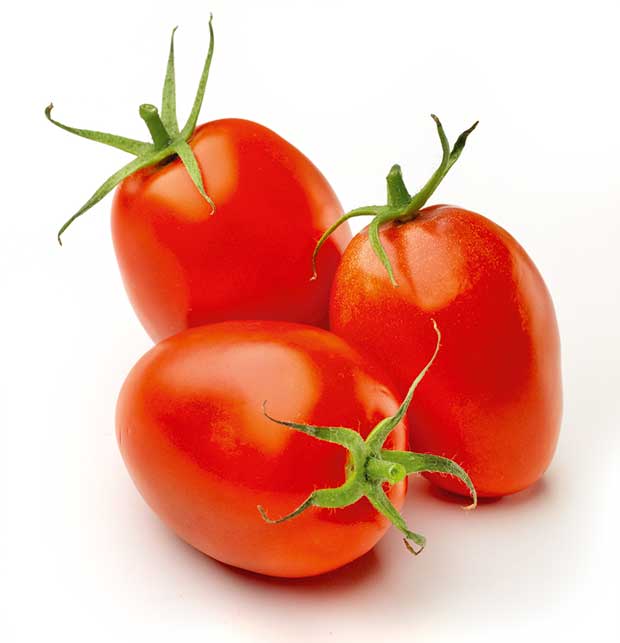
Roma.
They can also be served fresh, if that’s your preference, or used to top pizzas. They are also great for drying.
FRESH
Beefsteak tomatoes are the biggest of all and excellent for slicing in sandwiches. They have numerous small pulp compartments and the pulp is fairly compressed which means they hold together well when sliced.
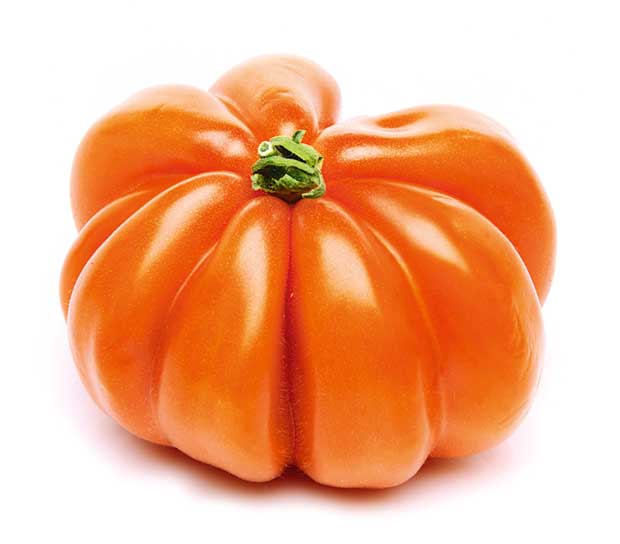
Beefsteak.
However, because they have a relatively high fruit-wall-to-pulp ratio, they are also useful for cooking.
HARDINESS TO DISEASE/CLIMATE
If you’re looking for a sturdy tom, hybrids may be more your thing. They are bred for their disease resistance and high yields.
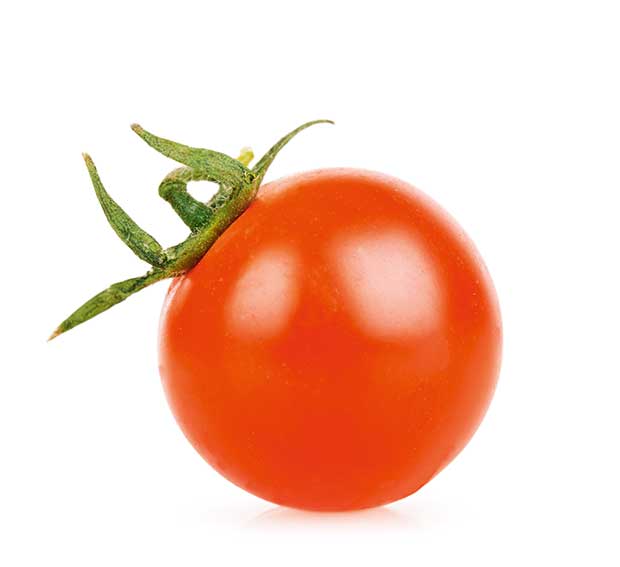
HERITAGE OR HEIRLOOMS
These have been saved over generations for their great flavour. It’s hard to resist some of the names too: Amazon Chocolate, Black Elephant, Bloody Butcher, Berkeley Tie Dye Pink, Vintage Wine.
DETERMINATE/BUSH TOMATOES
These are generally compact, growing 60-90cm high. They bear their crop all at once. They’re well-suited to container growing because of their small size.
INDETERMINATE/(VINE) TOMATOES
These can reach impressive heights. If trained with a single or double leader (they can be espaliered along a wall or wires) they can reach 2.5-3m high. They bear their fruit over the course of the season and will continue to grow and set fruit until the cooler weather arrives.
WHAT’S THE MOST UNUSUAL TOMATO YOU CAN FIND?
Possibly that honour goes to Cream Sausage, a creamy yellow, sausage-shaped staking tomato. It’s a new addition to the Kings Seeds catalogue this year, so the jury is still out on what it tastes like. The World Tomato Society describes it as having “very good sweet flavours, great for making a sweet salsa or a delicious yellow pasta sauce.”
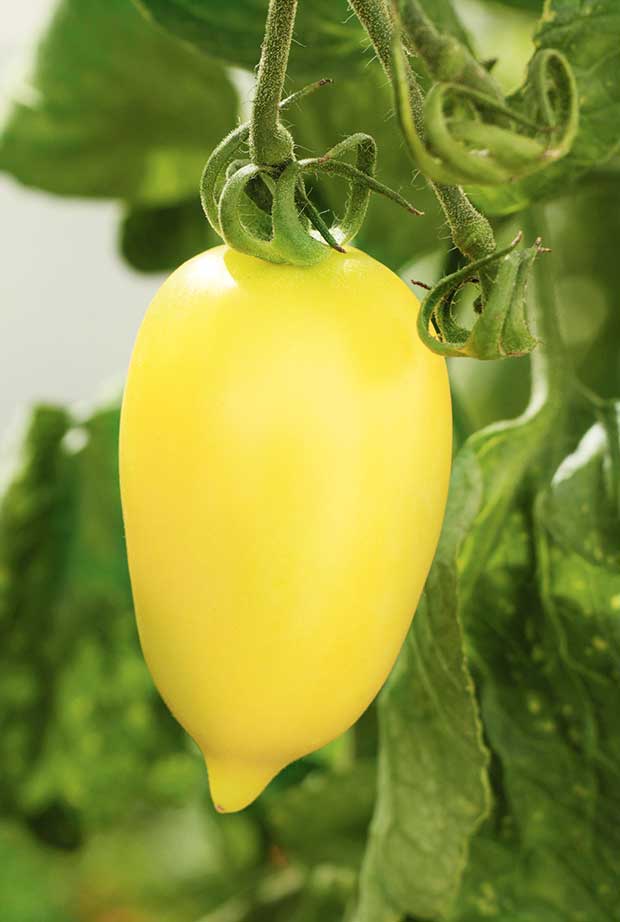
Cream Sausage.
WHY YOU SHOULD CHOOSE BURBANK
One of the high-scoring all-trans-lycopene tomatoes is the heritage variety Burbank (score 8.56), a flavourful, medium-sized tomato available from Koanga Institute.
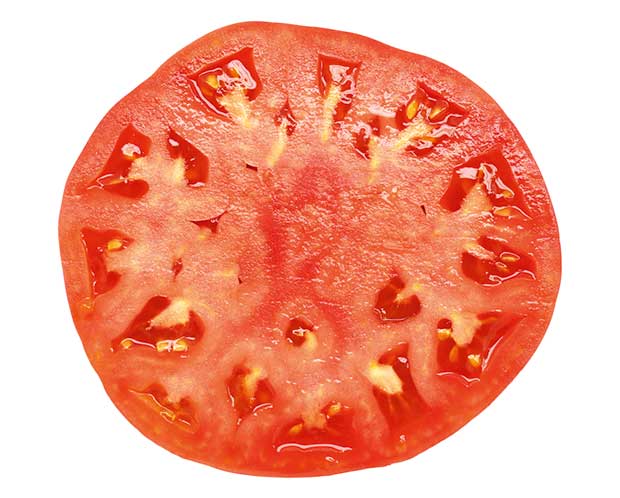
30+ TOP TOMATOES
We asked Mark Christensen of Heritage Food Crops Research Trust, Kay Baxter of Koanga Institute, and Gerard Martin of Kings Seeds to give us their favourite tomato choices.
Healthiest tomato
Mark’s choice: Olga’s Round Golden Chicken Egg, one of the richest in the most readily-absorbed form of lycopene with a level of 7.27 – it grows better for us than Amish Yellowish Orange Oxheart (which scores highest). It is a good all-round tomato.
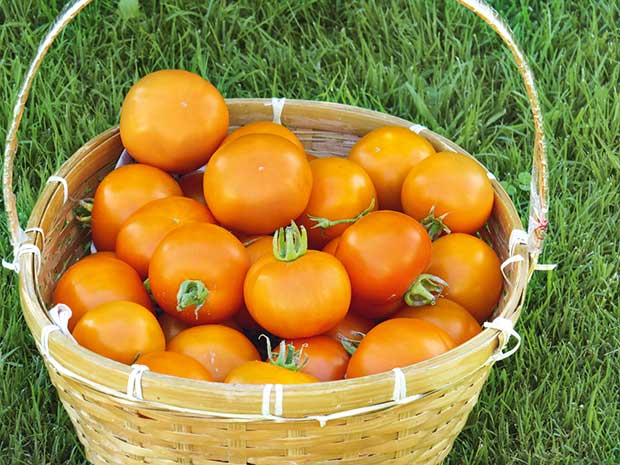
Olga.
Kay’s choice: The overall healthiest depends upon how they are eaten; cooked and then fermented is best – way, way more nutrition (as shown in Koanga’s cook book Body and Soul).
Gerard’s Choice: Orange tomatoes have more readily available lycopene than red ones. Option: Chef’s Choice Orange.
Sweetest tomato
Mark’s Choice: Golden Eye, a small golden cherry with the highest level of beta- carotene.
Kay’s Choice: Black Cherry Burbank, Margaret Curtain, Oxheart, Riverside Market, Island Bay, Small Sweet Orange and Tommy Toe win our trials every year.
Gerard’s Choice: Gardener’s Delight is our biggest seller. It produces abundant, grape-like bunches of cherry tomatoes until first frost.
Best for sauce
Mark’s choice: You are probably looking for a tomato over 100g for sauce. I’d choose Tangerine. Excellent bright orange colour, ideal size and flavour for sauce. Has a tetra-cis-lycopene level of 5.82.
Kay’s choice: Oxheart, Island Bay, Croatian, Black/Orange Roma.
Gerard’s choice: San Marzano, Andiamo, Roma.
Best for sandwiches
Mark’s choice: Golden Green, a medium-sized slicer-style, firm tomato with a very good flavour. Has a tetra-cis-lycopene level of 7.12.
Kay’s choice: The firm Watermouth and Burbank, Riverside Market and Oxheart. We sell a cherry tomato mix, our best-selling seeds.
Gerard’s choice: Best Boy Bush and Midnight.
Best for salads
Mark’s choice: Mini Orange, abundant, bite-sized tomatoes, stunning orange colour that is very eye-catching in a salad. Has a tetra-cis-lycopene level of 3.36.
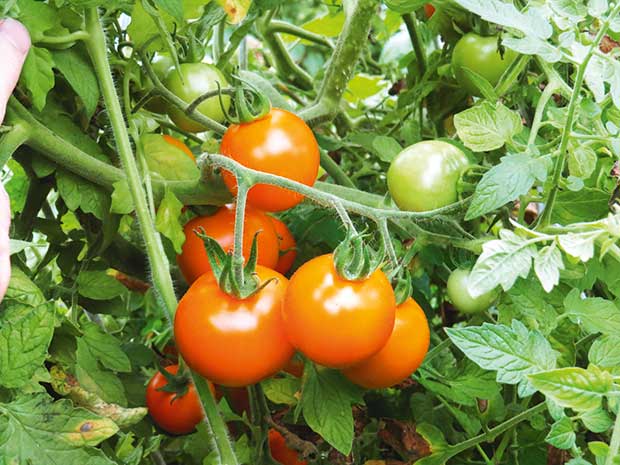
Mini Orange.
Kay’s choice: I just choose whatever colour, shape and variety I feel like at the time. I always have a large range available and find my choice changes every day.
Gerard’s choice: Diplom in the organic section, and Black Cherry.
Most prolific
Mark’s choice: Tangella, excellent golf ball-sized tomatoes. It’s a beautiful golden colour and very appealing to children. Has a tetra-cis-lycopene level of 6.13.
Kay’s choice: Oxheart, Watermouth and Burbank.
Gerard’s choice: Black Cherry and Gardener’s Delight, although the new Patio Choice Yellow will push for second or third place. It’s a hanging basket, big tub yellow cherry tomato, an American award-winner that has hundreds of tasty crack-resistant fruit. My freezer trays are full with surplus from only two plants.
Best for North Island
Mark’s choice: Moonglow, winner of an heirloom tomato tasting competition in the USA, has a tetra-cis-lycopene level of 5.38.
Kay’s choice: Alma for drying, Oxheart for saucing, Watermouth for slicing, cherries for salads and raw.
Gerard’s choice: Chefs Choice Orange, Black Cherry and Diplom.
Best for South Island
Mark’s choice: Olga’s Round Golden Chicken Egg, an heirloom from Siberia. Easy to grow, excellent flavour, has a tetra-cis-lycopene level of 7.27.
Kay’s choice: Scotland Yellow, amazing, reliable; Henry’s Dwarf Bush Cherry, easy to grow; Yellow Pear, great cherry tomato and a South Island heirloom.
Gerard’s choice: Hybrids to get them a bit earlier: Andiamo, Best Boy Bush and Early Doll.
WHERE TO FIND TOMATO SEEDS
Kings Seeds
Koanga Institute
Bristol Plants & Seeds (heritage tomato seed grown and researched by Heritage Food Crops Research Trust can be bought here)
Love this story? Subscribe now!
 This article first appeared in NZ Lifestyle Block Magazine.
This article first appeared in NZ Lifestyle Block Magazine.
